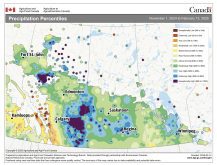Canadian exporters demand similar action, but feds say legislation already exists to address ‘anti-competitive’ practices
Exporters of Canadian agricultural products are looking with envy at legislation wending its way through the U.S. Congress.
The House of Representatives and Senate have both passed versions of the Ocean Shipping Reform Act, which would give more regulatory oversight to the Federal Maritime Commission.
The legislation is in response to shipper complaints about the unwillingness of ocean carriers to provide empty containers for the export of U.S. products, including agricultural goods.
Greg Northey, vice-president of corporate affairs with Pulse Canada and spokesperson for the Coalition to Fix the Container Crunch, applauds what is happening south of the border.
Read Also

Saskatchewan looks to expand trade in Indonesia
Saskatchewan intends to increase its agricultural partnership with Indonesia.
“That is exactly what we’d like to see,” he said.
“This has to be the direction that Canada goes as well.”
But it doesn’t appear to be the direction Canada is heading because there are no indications similar legislation is being contemplated in this country.
“We’re very, very far behind on this in Canada, unfortunately,” said Northey.
Transport Canada spokesperson Sau Sau Liu said the federal government is watching what is happening in other jurisdictions, including the United States and the European Union.
“In Canada, a sound legislative framework exists in the Competition Act to address anti-competitive behaviour,” she said in an email.
Transport Canada has commissioned an independent study of Canada’s container shipping competition legislation.
It has also met with industry representatives on numerous occasions to better understand “the extent, evolution and impacts of container availability concerns.”
Transportation minister Omar Alghabra hosted a National Supply Chain Summit on Jan. 31 to hear more from various stakeholders on the issue.
“Next steps include the creation of a Supply Chain Task Force and continued engagement with industry stakeholders and provincial and territorial partners to identify the range of short and long-term actions that could be taken to improve supply chain efficiency and resiliency,” said Liu.
Northey said nothing much has changed with the container crunch that has been hampering exports for 23 months.
Shipping lines are still reluctant to supply empty containers for export, curtailing trade routes, rolling bookings and charging excessive rates for the metal boxes.
“All of that is still in play,” he said.
And he expects it to stay that way because companies make more money shipping empty containers back to China immediately rather than waiting for them to be filled with items for export.
Canadian farmers harvested a short crop last year, so the problem isn’t as pronounced as it would have been if there had been a bumper crop that had to be moved.
Northey said the solution is to follow the American example and give the regulator more clout to deal with the shipping lines.
Unfortunately, it takes years for legislation to get passed in Canada and there has yet to be any indication that the government is even leaning in that direction.
The impetus in the U.S. came last summer when president Joe Biden ordered U.S. transportation agencies to crack down on anti-competitive conduct by railways and ocean carriers.
Northey said the House version of the Ocean Shipping Reform Act is more heavy-handed, essentially saying shippers cannot decline export bookings.
“There was a lot of pushback on that from the ocean carriers,” he said.
The Senate version is more in line with Canada’s rail legislation aimed at ensuring service is reasonable.
“It’s more of a complaint-driven, rule-driven thing as opposed to, ‘thou shalt not,’ ” he said.
Northey expects the final version of the bill will look more like the Senate one.
Either way, the legislation represents a major development in the shipping industry, a new approach to regulation that he hopes will soon trickle north of the border into Canada.
















